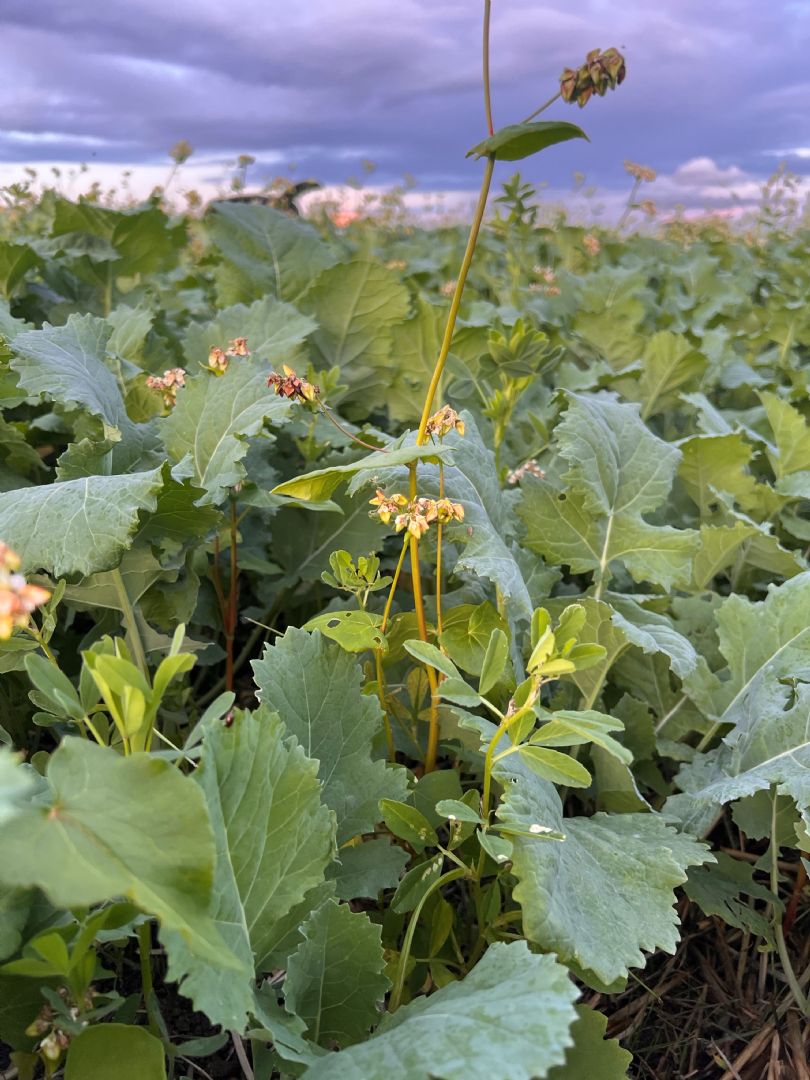
Companion cropping can be used as part of an integrated pest management (IPM) strategy, reducing or eliminating the requirement for pesticide, while inclusion of legumes can reduce the quantity of fertiliser needed.
Tom Martin, from Village Farm near Peterborough, has grown a combination of berseem clover, fenugreek and buckwheat along with oilseed rape (OSR), to combat cabbage stem flea beetle.
Cabbage stem flea beetle
A thorn in the side of OSR growers up and down the country, many farmers will be familiar with the challenges of cabbage stem flea beetle, which can lead to yield losses or in some cases crop failure.
Resistance to insecticides can be a real problem with cabbage stem flea beetle. When Tom tested the resistance of the cabbage stem flea beetle on his farm five years ago, he found that 25% were resistant to pyrethroid insecticides. “We decided to stop using insecticide for control, as we didn’t want to end up with up to 100% becoming resistant,” he says.
There were other options available. To find plants to consume, cabbage stem flea beetles seek out the brassica smell and look for a green target on a brown background. Tom decided to try growing OSR with a combination of companion crops to make it difficult for the beetle to find it, while also supporting the nutrient requirements of the crop.
OSR’s trio of companions
For the last five years, OSR on Village Farm has been grown with buckwheat, fenugreek and berseem clover companion crops. Each species supports the OSR crop in different ways:
Buckwheat
Buckwheat grows fast and covers the ground quickly. This makes it tricky for cabbage stem flea beetles to find the OSR, as they are less able to detect the green target on a brown background.
Fenugreek
Fenugreek gives off a curry-like smell which masks the smell of the OSR, making it more difficult for cabbage stem flea beetles to find it. It is also a legume, so fixes nitrogen from the air, which can help reduce fertiliser requirements.
Berseem clover
Also known as Egyptian clover, berseem clover is an annual clover which effectively fixes nitrogen.
Management of the OSR companion crop trio
The berseem clover and buckwheat are frost sensitive, so are killed off by the frost over winter. While growing, buckwheat is effective at scavenging phosphate, so when it dies off the phosphates are released back into the soil where they become available for the OSR to use once it starts rooting and shooting in the spring.
Similarly, when the berseem clover dies off it releases the nitrogen it has fixed, making it available to the cash crop. The fenugreek is sprayed off in the spring, also releasing some nitrogen back into the soil.
Tom shares that he uses an EasyDrill from Sky Agriculture to drill the OSR and its companion crops. The drill has multiple tanks, so it can be used to drill different things at different depths at the same time. “One pass does a lot of work, I can sow rapeseed, fertiliser, all three companion crops and even mix in some slug pellets at same time,” he says.
Silica spray
In addition to growing OSR with the trio of companion crops, Tom has also used a silica-based spray on OSR which strengthens the cell wall, making the plant less palatable to cabbage stem flea beetle. The spray also contains bacteria that disrupt the digestive system of the flea beetle, further supporting the protection of the cash crop from damage.
An evolving approach
Tom explains that he started using the companion trio by learning the theory around the effects of different companion crops, coming up with a hypothesis for a combination which might work on his farm, then simply trying it out.
Since introducing the companion cropping and the use of silica spray, no insecticide has been used to control cabbage stem flea beetle, nor has any OSR crop been lost due to the pest.
“We are continuing to evolve it,” he says. “Normally we use 3-5kg/ha berseem clover seed, a similar amount of fenugreek and 5kg/ha of buckwheat. This year we’ve used up to 11kg/ha buckwheat, because we’ve seen positive responses in terms of possible allelopathic effects on blackgrass, so decided to put a bit more in.”
“We are also now growing our own buckwheat seed, which will improve profitability as we use more of it,” Tom adds.
“We have lots of challenges on-farm, and lose crops to things like pigeons and slugs, but no longer cabbage stem flea beetle,” Tom concludes.




